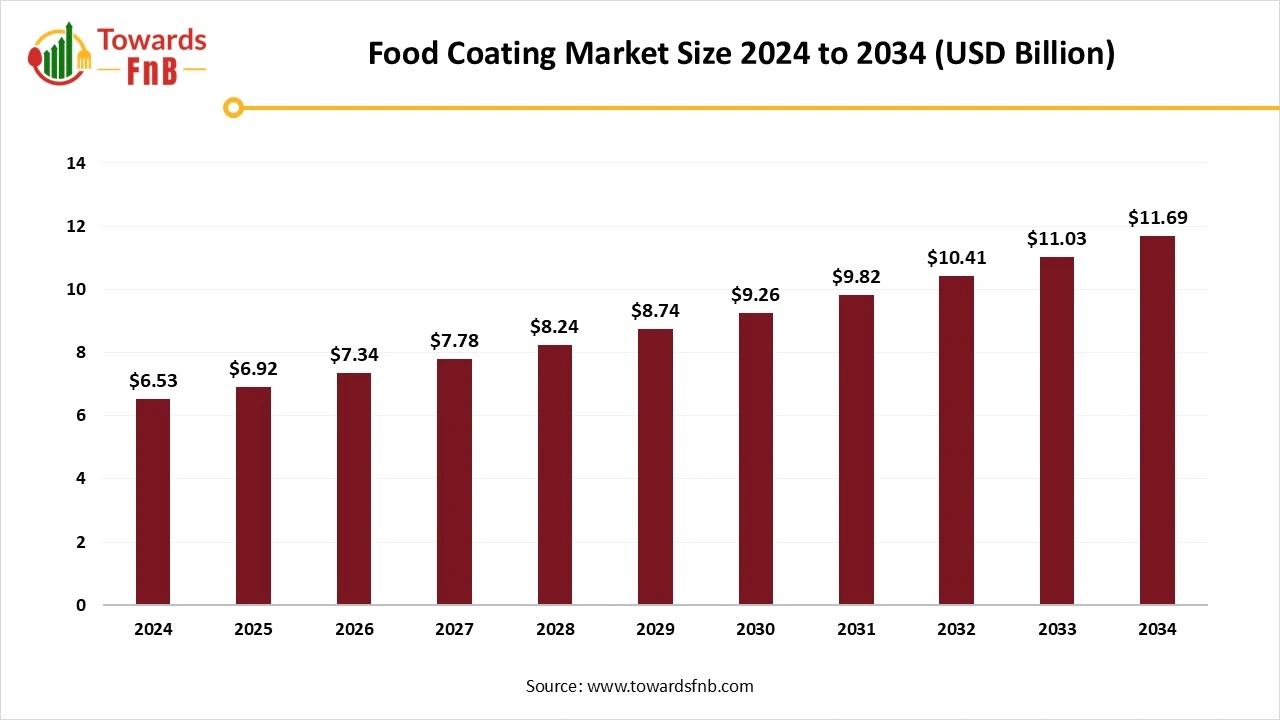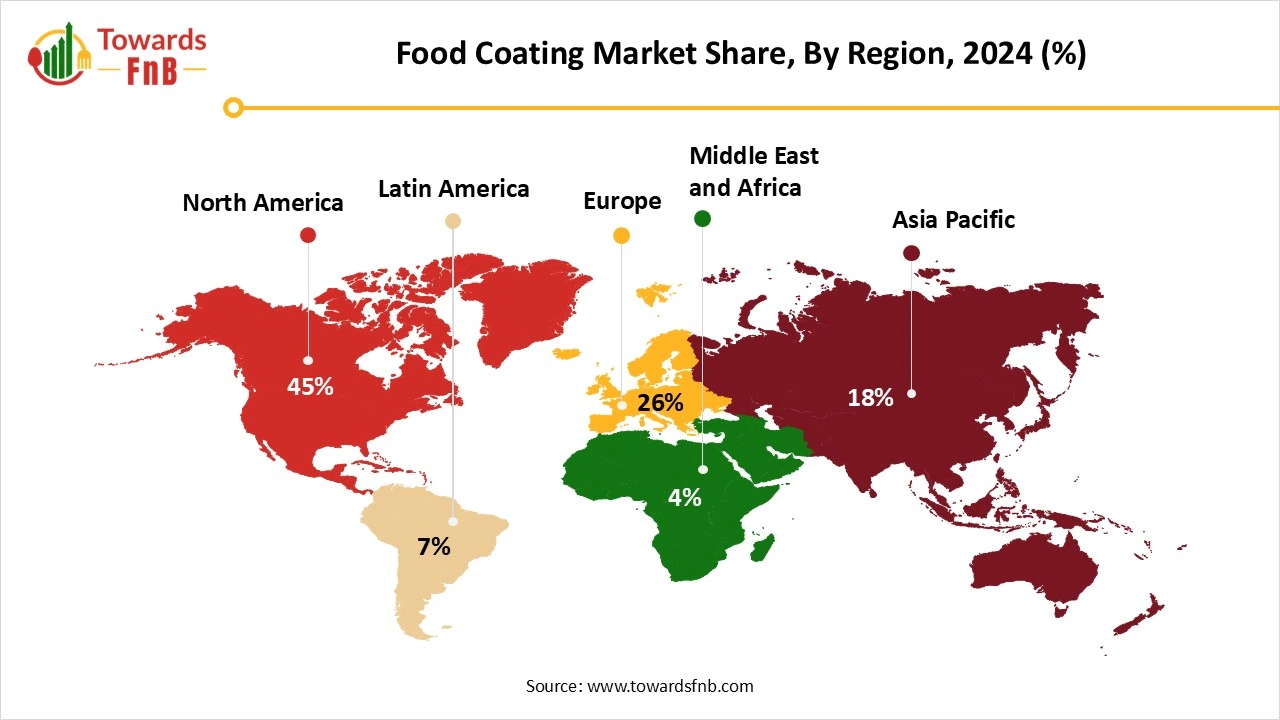November 2025
The global food coating market size was calculated at USD 6.53 billion in 2024 with projections indicating a rise from USD 6.92 billion in 2025 to approximately USD 11.69 billion by 2034, expanding at a CAGR of 6% throughout the forecast period from 2025 to 2034. The food coating industry is driven by rising consumer demand for processed products and the growing popularity of healthier, more nutritious coated products.

| Study Coverage | Details |
| Growth Rate from 2025 to 2034 | CAGR of 6% |
| Market Size in 2025 | USD 6.92 Billion |
| Market Size in 2026 | USD 7.34 Billion |
| Market Size by 2034 | USD 11.69 Billion |
| Largest Market | North America |
| Base Year | 2024 |
| Forecast Period | 2025 to 2034 |
| Regions Covered | North America, Europe, Asia-Pacific, Latin America, and Middle East & Africa |
The food coating market involves ingredients and equipment used to apply layers of batter, breading, or glazing on food products to enhance texture, flavor, appearance, and shelf life. Coatings are applied to meat, poultry, seafood, snacks, bakery items, and confectionery products to enhance crispness, improve flavor retention, or provide moisture barriers. The market includes dry and wet coating ingredients, as well as coating machinery used in industrial processing. Demand is driven by growing convenience food consumption, clean-label ingredients, and innovative texture/flavor offerings.
Major technological progress in the food coating sector involves innovations to increase shelf life, enhance food safety, and develop sustainable options through techniques such as nanotechnology, composite coatings, and natural additives. Nanotechnology enables the development of nanoemulsions that enhance the delivery of beneficial substances, such as antioxidants and antimicrobials. Composite coatings that blend various biopolymers provide enhanced barrier characteristics, and natural additives, along with biopolymers such as chitosan, pectin, and protein, serve as alternatives to synthetic preservatives.
Raw Material Procurement
Processing for Food Coating
Distribution and Logistics
North American Food Coating Market Leads Global Forecasts
North America dominated the food coating market with a 45.8% share in 2024. The vast fast-food sector in North America requires a considerable amount of coated food components. The coating of food products helps meet the rising demand to extend shelf life in response to the escalating food trade, improve sensory qualities, and preserve overall quality. Consequently, it propels the market ahead. The food coating sector is projected to be led by the North American region throughout the forecast period, driven by advanced food coating technologies and the use of automated equipment for coating food ingredients.
U.S. Food Coating Market Insights
The U.S. significantly influences regional trends through its extensive output of processed foods, robust consumer demand for flavored and coated snacks, and ongoing product innovation from major companies. American manufacturers are leading the way in launching new coatings that align with changing dietary trends, including low-sugar, plant-based, and gluten-free options. Key factors encompass automation, the growth of fast-food establishments, and advancements in coating technologies to enhance taste, texture, and longevity.

The Booming Market for Coated Food in the Asia Pacific
The Asia Pacific region anticipates substantial growth with a 7.5% CAGR throughout the projected period. The rise in popularity of fast-food establishments, commonly known as quick-service restaurants (QSRs), is significantly driving the expansion of the food coatings market in the Asia-Pacific. China and Japan are the top consumers of food coatings, driven by their large populations and the rise of quick-service restaurants such as McDonald's, Burger King, Wendy’s, Subway, and Dunkin’ Donuts. The QSR chain industry in India is projected to expand eightfold by 2025, driven by rising disposable incomes and greater urbanization, leading to increased consumption of food coatings.
India Food Coating Market Insights
The food coating sector in India is essential to the food processing sector, enabling improvements in the texture, visual appeal, and taste of numerous products. The market has experienced significant growth driven by rising demand for convenience and processed foods. As consumers pursue richer, more varied flavor experiences, the food coating market in India is projected to grow further.
Meeting Rising Demand: The Role of Food Coatings in European Food Trade
Europe is seeing an increase in the use of local food coating ingredients, driven by expanding food processing, higher investments in innovative processing technologies, and demand for sustainable, high-quality food products. Producers are increasingly focusing on functional coatings that enhance shelf-life, product stability, and sensory appeal in processed foods. The growing focus on natural, allergen-free, and clean-label products is driving demand for innovative coating formulations. The increased application of coatings in snacks, dairy, and frozen items underscores how technological progress is enhancing the use of local food coating components within the food processing industry.
Germany Food Coating Market Insights
Germany's need for food coatings is robust, fueled by its status as a frontrunner in European food technology and its substantial food processing sector. A notable transition towards environmentally friendly, sustainable options is underway, driving increased demand for natural, allergen-free, and biodegradable coatings. The increasing demand for plant-based foods is driving the need for plant-sourced coating components, such as starches and proteins.
Key Drivers of Middle East and Africa Food Coating Demand
The expansion of the food coating market in the Middle East and Africa is driven by rising demand for processed, convenient food items, especially in urban regions experiencing population growth and modernization. Rising consumer demand for convenient foods that offer better taste, texture, and appearance has led to increased use of coating ingredients in meat, snacks, and baked goods. The growth of fast-food chains and quick-service restaurants in major nations has also greatly increased the need for coating solutions.
UAE Food Coating Market Insights
The need for food coating in the UAE is increasing, fueled by a thriving food and beverage industry, a surge in convenient and processed food, and heightened consumer awareness regarding product safety. Primary factors include the need for specific coatings for uses such as meat/seafood and sweets, advancements in eco-friendly, health-conscious coatings, and technological improvements that enhance product efficacy and longevity.
Inside the Latin American Food Coating Boom
The demand for food coatings in Latin America is on the rise, driven by the growing popularity of processed and convenient foods such as snacks and frozen meat, as well as a consumer inclination towards coatings that enhance flavor and texture. Major factors include abundant agricultural resources, especially in Brazil and Argentina, the growth of modern retail, and technological innovations that enhance shelf life and increase the accessibility of coated items. Growth is further bolstered by trends in health-oriented choices such as gluten-free and protein-rich coatings.
Brazil Food Coating Market Insights
Brazil's diverse climate and robust agricultural sector provide a conducive environment for the adoption of plant-based coatings. The country's extensive production of fruits and vegetables necessitates effective preservation methods, enhancing the demand for edible films and coatings. Moreover, the government's initiatives to promote sustainable agricultural practices further bolster the market's expansion in the region.
Which Type of Food Coating Dominated the Food Coating Market?
Batter coatings segment led the food coating market with a 56.5% share in 2024, driven by the growing demand for processed and convenience foods, fast food establishments, and plant-based options. The demand is further supported by consumers' preference for specific textures, especially the crunchiness that batters provide, and an increasing inclination toward healthier, natural choices. Innovations aim to lower fat levels while enhancing moisture and crunchiness.
Specialty Coating Segment is Observed to Grow at a CAGR of 6.8% During the Forecast Period.
The rising popularity of convenience foods, an emphasis on healthier, natural ingredients, and the desire for functional benefits such as longer shelf life and enhanced texture are driving demand for specialty food coatings. This is generating a considerable demand for specialized coatings for items such as frozen meals, lightly processed fruits, and snacks.
The flour coatings segment is experiencing significant growth throughout the forecast period. The superiority is ascribed to flour's versatility and affordability as a coating alternative. It is commonly employed to generate different textures (crunchy, velvety), serve as a foundation for batters and coatings, and enhance the visual appeal and longevity of products. Flour coatings are widely used in high-demand applications such as meat and seafood products.
Which Ingredient Type Segment Dominated the Food Coating Market?
The batter mixes segment held the dominating share of 32.4% in the food coating market in 2024. Batter premixes are convenient and eliminate the need to measure and mix individual components, greatly reducing time and labor in commercial kitchens and high-volume food production. Batters can be used on a variety of food products, such as meat, poultry, seafood, and vegetables, and are appropriate for different cooking techniques, including frying and baking. This flexibility enables producers and cooks to develop a variety of menu choices.
The Seasonings & Spices Segment is Seen to Grow at a 6.7% CAGR During the Predicted Timeframe.
Because of factors such as consumer interest in distinctive and strong flavors, a rise in health awareness, and the adaptability of spices in shaping flavor profiles for convenience foods. Spices are regarded as a natural means to improve flavor, and the clean-label movement has increased their application in organic and minimally processed coverings.
The starches segment is growing rapidly because of its adaptability, affordability, and alignment with consumer preferences for natural and sustainable products. Being a naturally occurring, readily accessible polysaccharide, it is economical and serves multiple purposes, with its protective and film-forming characteristics helping prolong shelf life.
Which Application Segment Dominated the Food Coating Market?
Meat & poultry segment dominated the market with the largest share of 36.5% in 2024, attributed to strong demand from the fast-food and ready-to-eat industries, fueled by consumer preferences for a crunchy texture and enhanced flavor. Coatings improve the appearance and taste of meat and poultry items, and the increasing demand for these products, along with frozen and easy meal solutions, drives this leadership.
Snack Segment is Expected to Grow at a 6.5% CAGR in the Food Coating Industry During the Forecast Period.
Due to rising consumer preference for convenient, tasty, and portable snacks, which manufacturers enhance with coatings for better texture, flavor, and visual appeal. This encompasses a diverse range of coated products, including nuts, seeds, candies, and savory treats, with coatings that help prolong shelf life and maintain quality during production and storage.
The fruit and vegetables segment is expanding quickly in the food coating market, as coatings are crucial for prolonging their limited shelf life, minimizing post-harvest losses, and preserving quality during shipping. There is an increasing tendency for fresh, natural foods. Edible, plant-derived coatings are considered a clean-label option that meets consumer demand for preservative-free products.
Why did the Processed Food Industry Dominate the Food Coating Market?
Processed food industry segment held the largest share of 62.5% the food coating market in 2024, since coatings enhance shelf life, improve taste and texture, and satisfy consumer needs for convenience and ready-to-eat items. These functional advantages are crucial for items such as snacks, baked goods, and frozen meals, rendering coatings an essential element in large-scale production. Moreover, improvements in food technology and coating machinery have allowed large-scale producers to apply these methods effectively.
The Foodservice/HORECA Segment is Expected to Grow at a 6.8% CAGR During the Forecast Period.
Driven by the substantial demand for processed and convenience food items from these establishments and the necessity for food coatings to maintain product quality, consistency, and visual attractiveness. This is especially crucial for large-scale operations and catering services, helping minimize food waste and control inventory costs.
BioBond
Maggi
By Type
By Ingredient Type
By Application
By End-Use
By Region
November 2025
November 2025
November 2025
November 2025